Types of euphorbia: 16 stunning varieties for beds, borders and pots
These types of euphorbia will bring a zesty, versatile beauty to every type of garden, big and small


These inspirational types of euphorbia are guaranteed to add zest to all kinds of beds, borders and pots. They bring lively color and interest with brilliant spring blooms in shades of lime-green, yellow and orange. Many euphorbias also have evergreen leaves, offering unique structure all year round. So they fit very easily into the must-have plant category.
With around 2,200 species, euphorbias are the second largest genus of plants in the world. Whether you’re looking for classic grey-green foliage or red and maroon shades to complement your flowerbed ideas, there are bound to be several types of euphorbia to suit whatever growing conditions you have in your garden.
Euphorbias can be found growing in an extraordinary range of landscapes, from mountains to deserts to temperate forests. There are many species and cultivars, and even more are being bred, so there is a vast choice. You’ll find varieties that work in sun and shade, dry soils and damp. They vary enormously, from succulent cowboy cactus types like Euphorbia ammak, right through smaller and larger shrubby varieties with bottlebrush stems, to low spreading clumps.
While euphorbias may vary in form and leaf color, from grey green to rich maroons, the flowers gain their intensity from the leafy bracts around the central blooms. They look good for weeks, even after the blooms are spent. This allows spring-flowering varieties to blend into hotter summer hues. Euphorbia griffithii ‘Dixter’ works well with cooler shaded camassias in late spring through to hot kniphofias in summer.
Many perennial euphorbias are known as ‘spurges’ or ‘milkweed’ – the reason being they share a milky white sap. This can be an irritant if it touches your skin, so wear gloves when cutting. Apart from that, the zingy tones of these types of euphorbia will bring only joy and pleasure to all manner of garden displays. Choose one of these dynamic early-summer staples and enjoy months of fresh seasonal interest.
16 types of euphorbia to liven up your early summer displays
The zingy greens of spring can’t fail to lift our spirits at the end of a long winter, from the first unfurlings of new leaves to shoots coming through bare soil. The greens of euphorbias take this to a whole new level, so choose one for your garden from this selection. These types of euphorbia vary in tone and structure – but all will brighten your garden borders and guarantee vibrancy and impact.
1. Euphorbia amygdaloides var. robbiae AGM
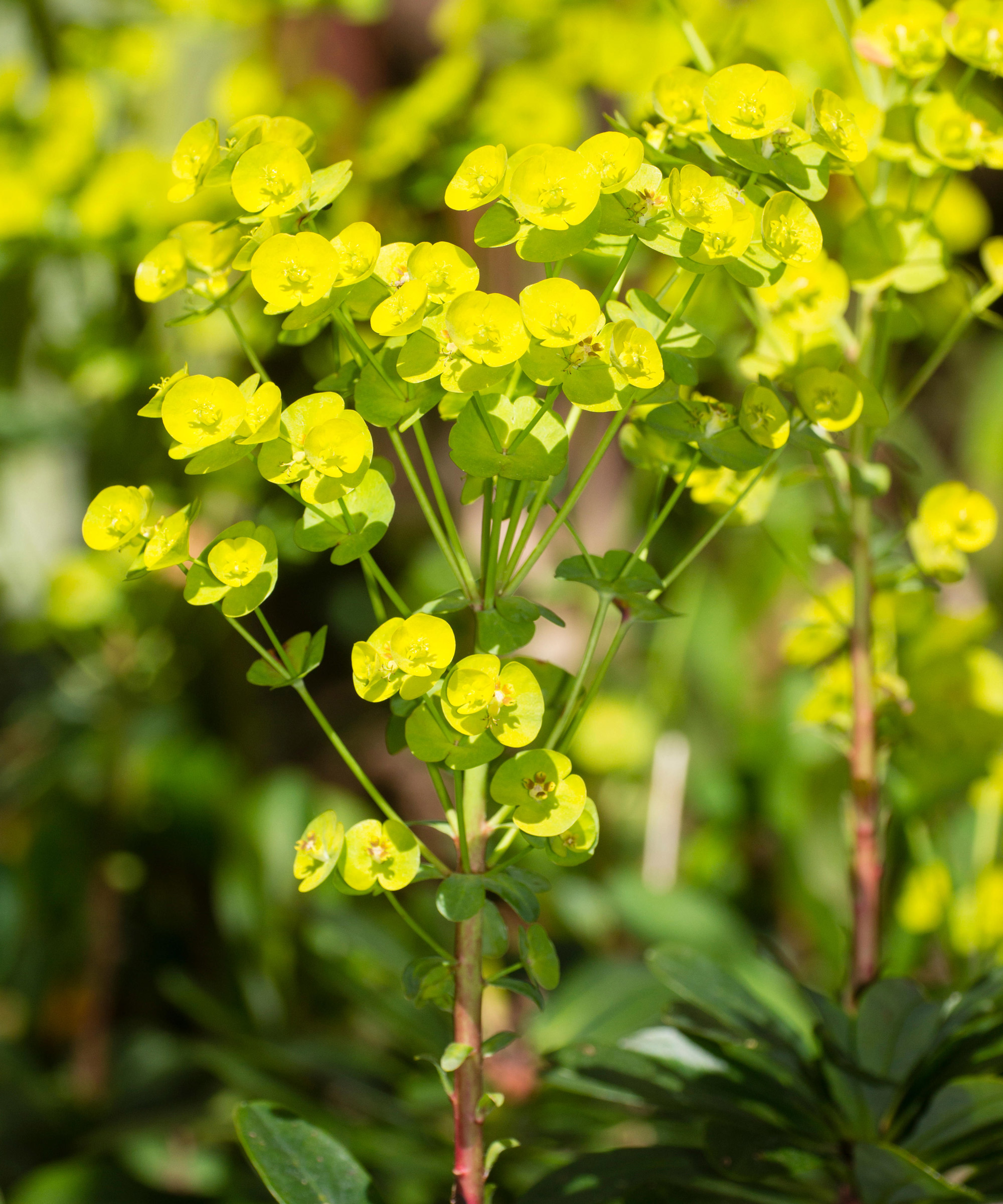
- Hardiness: USDA 6-8
- Height: 24in (60cm)
- Best for: Dry shade
Euphorbia amygdaloides var. robbiae is one of the most common varieties. This is a tough plant with the ability to solve the dry shade problem. If you’re looking for types of euphorbia that provide evergreen, spreading ground cover, this is perfect.
The lime green bracts of these euphorbias in spring add zing to woodland planting areas. They also look good with spring blues of forget-me-nots. Later, displays of certain types of delphiniums can also provide a stunning visual contrast with these euphorbias.
2. Euphorbia amygdaloides ‘Purpurea’
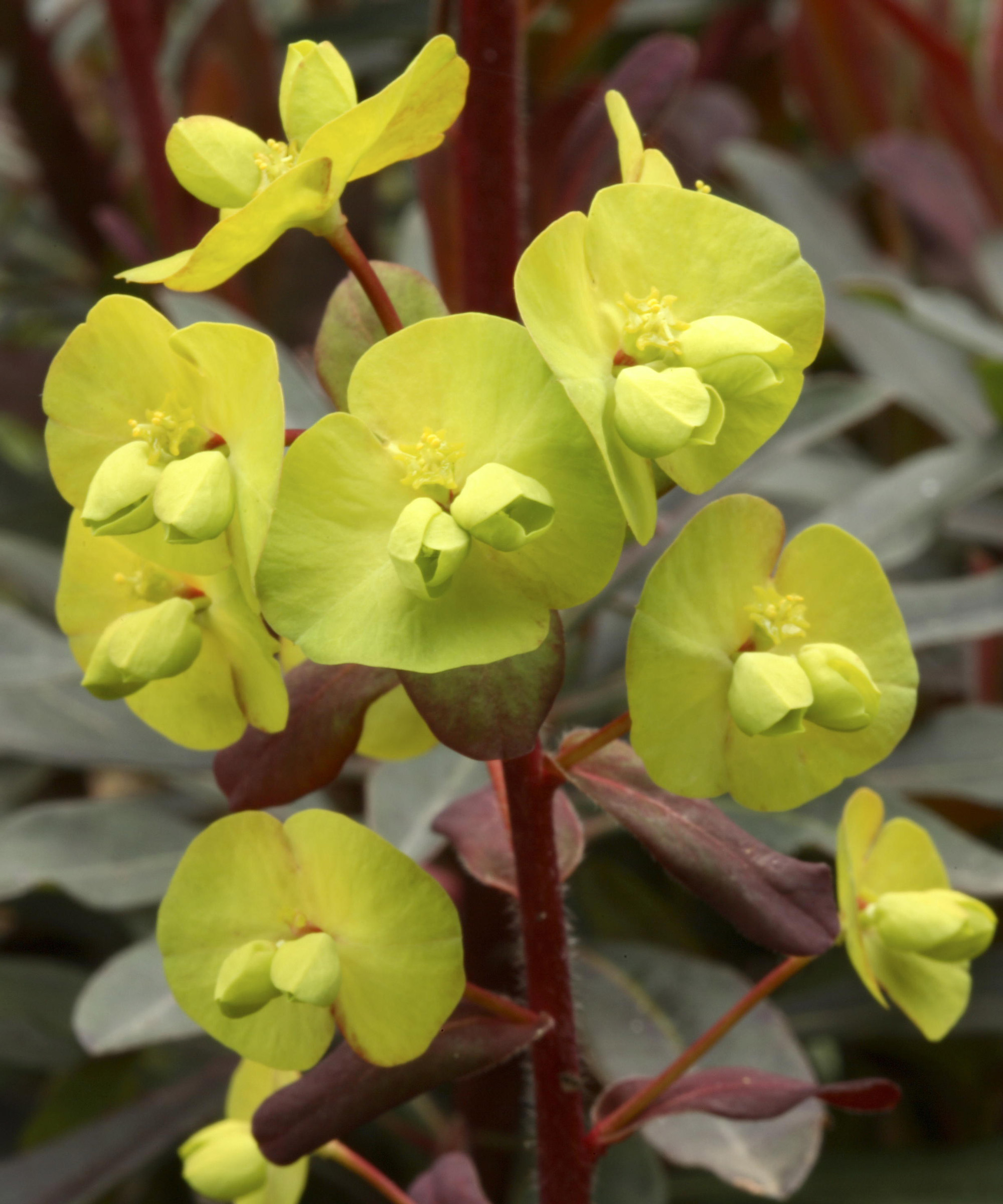
- Hardiness: USDA 6-8
- Height: 20in (50cm)
- Best for: Rich tones
If you are after adding tonal depth to a border then Euphorbia amygdaloides ‘Purpurea’ is one of the more interesting types of euphorbia to grow. Its maroon-tinged leaves make this a popular choice for adding rich tones to planting combinations.
These euphorbias will self-seed happily in the right conditions. If you have an interest in knowing how to grow ferns then this plant is an excellent planting partner. It also looks good planted in combination with carexes (sedges).
3. Euphorbia griffithii 'Fireglow'
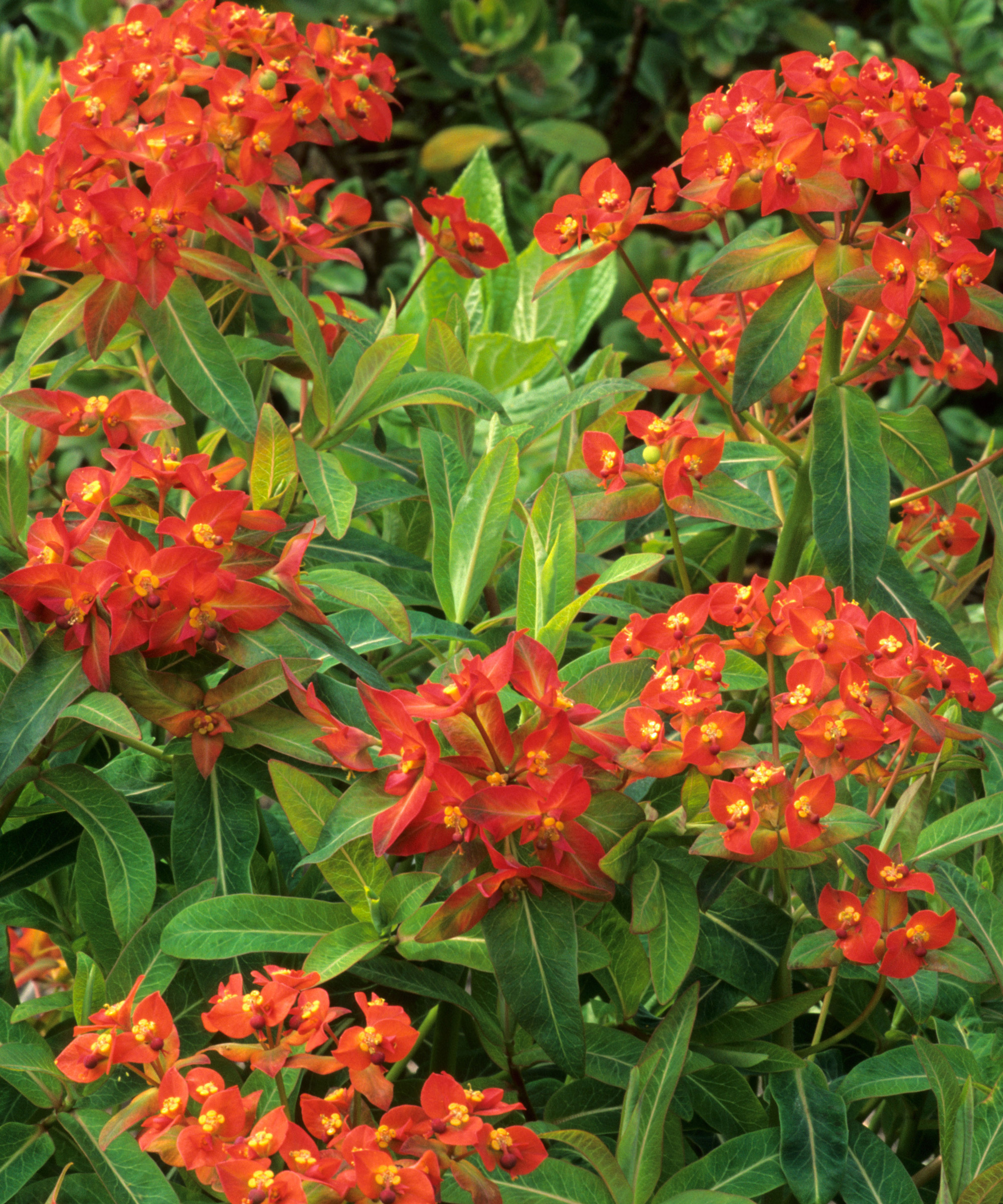
- Hardiness: USDA 4-9
- Height: 31in (80cm)
- Best for: Shady spots
Don’t despair if you’re faced with an under-performing shady garden corner – there are a few types of euphorbia perfect for you. Euphorbia griffithii 'Fireglow' is a glamorous addition to a shadier spot, with warm orange flowers in early summer.
As well as lending a cheerful warm glow to quiet corners, these shade loving plants are compact euphorbias that spread via rhizomes. They make really good ground cover, although they will die back over winter.
4. Euphorbia characias subsp. wulfenii
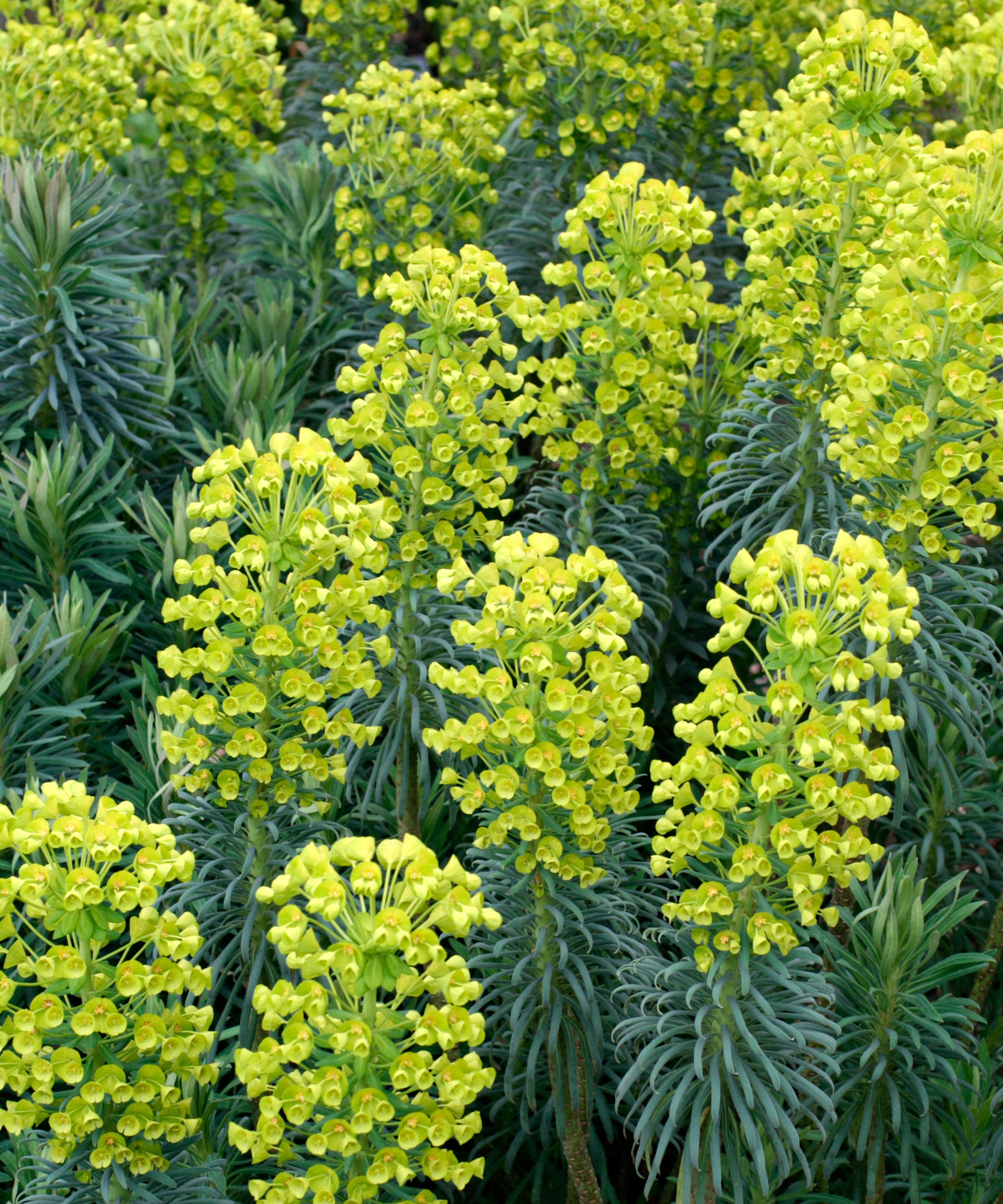
- Hardiness: USDA 7-10
- Height: 4ft (120cm)
- Best for: Full sun
For gardeners in search of effervescent south-facing garden ideas, Euphorbia characias subsp. wulfenii is one of the showier types of euphorbia to try. It’s a sublime choice for an evergreen border plant – and it’s also a tough player that does best in full sun.
These euphorbias have long stems with sage green bottlebrush leaves that look good all year round. And of course, their brilliant lime-green blooms in spring are an impressive foil for bulbs and shrubs.
5. Euphorbia griffithii ‘Dixter’
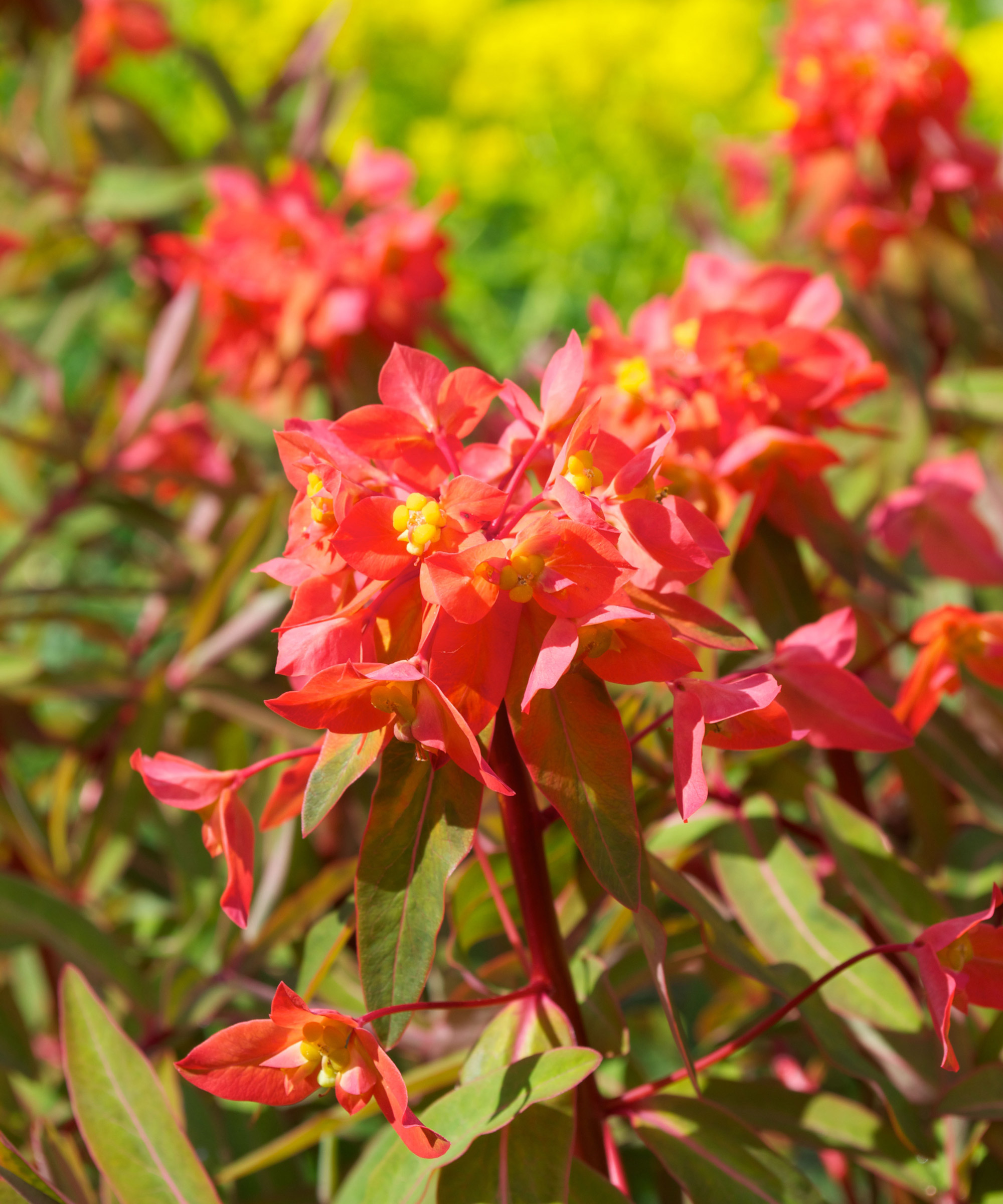
- Hardiness: USDA 4-9
- Height: 36in (90cm)
- Best for: Dappled shade
Lovers of legendary garden Great Dixter will adore this plant. Euphorbia griffithii ‘Dixter’ is a deciduous mid-height cultivar, introduced by famous gardener and gardening writer Christopher Lloyd. It is one of the easiest and most reliable types of euphorbia to grow.
If your garden color schemes involve warming up a space, this plant is more subtle than ‘Fireglow’ but still tonally striking, with red tinged leaves and lovely red bracts that appear in summer and last for weeks. Happy in damper soil in sun or dappled shade, these euphorbias form a generous bushy, upright mound of leaves over time.
6. Euphorbia mellifera AGM
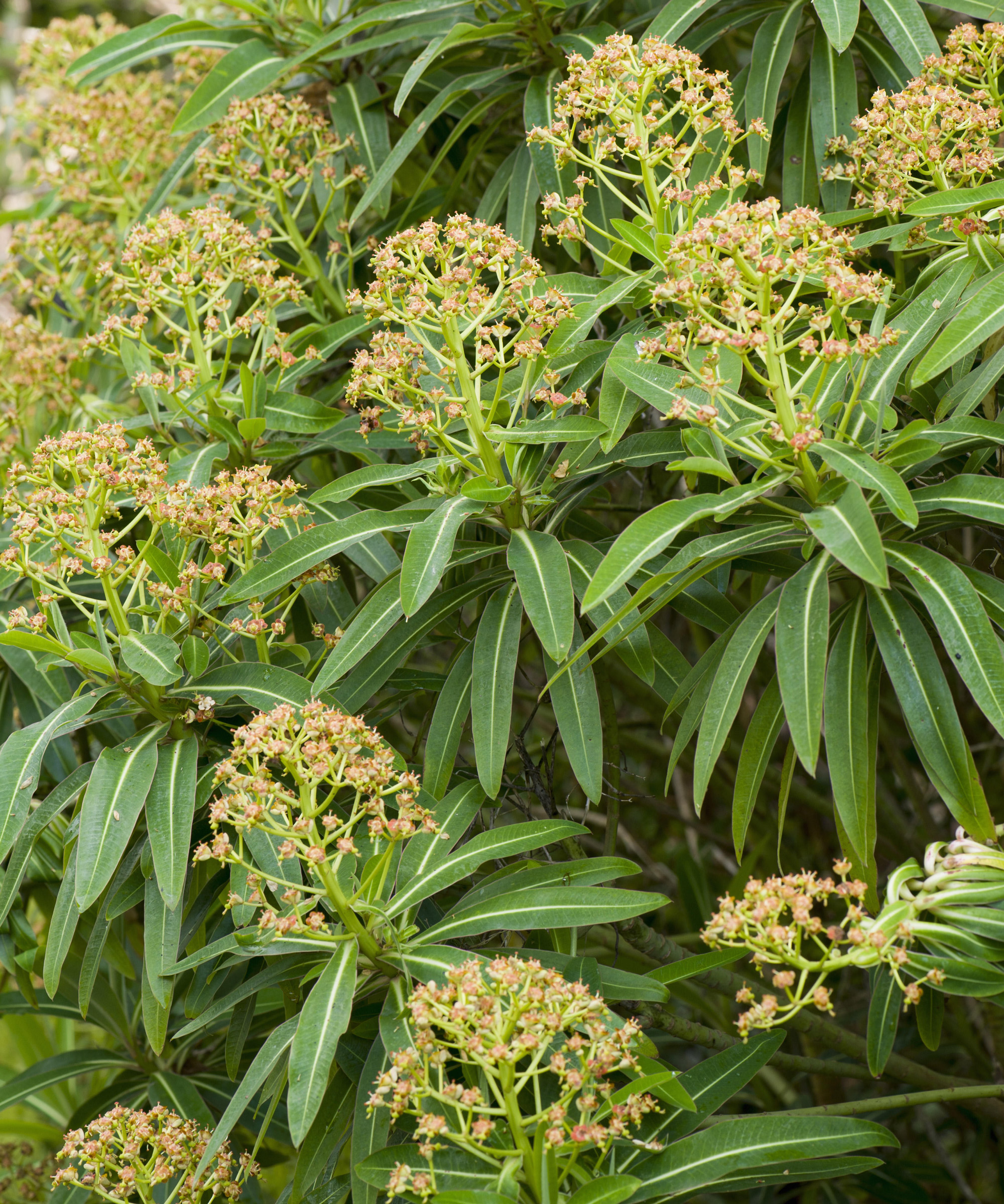
- Hardiness: USDA 8-9
- Height: 70in (1.8m)
- Best for: Sweet scent
There’s something a little bit special about these types of euphorbia. As with the best evergreen perennials, Euphorbia mellifera gives you all the benefits of evergreen foliage, plus early flowers. However, this RHS AGM winner has the added bonus of sweet, honey-scented blooms.
These euphorbias will grow into an open, shrubby form. They work well at the backs of borders. They are also lovely flanking more colorful patio gardening ideas or positioned near a terrace, where you can really enjoy the scent.
7. Euphorbia x pasteurii

- Hardiness: USDA 9-10
- Height: 60in (1.5m)
- Best for: Gravel plantings
This striking spurge is one of the rounded types of euphorbia with stiff, upward-curving stems. Euphorbia x pasteurii is a large evergreen shrub with a dome-like form. It works especially well with inventive garden gravel ideas or Mediterranean style plantings.
It is effectively a cross between Euphorbia stygiana and Euphorbia mellifera, and takes the best attributes of shape and color from both types. The dark green leaves of this vigorous euphorbia contrast well with its scented golden yellow flowers.
8. Euphorbia characias ‘Silver Swan’

- Hardiness: USDA 8-11
- Height: 46in (120cm)
- Best for: Drought tolerant planting
If you fancy a variegated euphorbia, you’re in luck. Euphorbia characias ‘Silver Swan’ is a tall, bushy euphorbia with creamy white edging to its leaves. This variegated shrubby Mediterranean type is very ornamental and it also has white flowers in spring.
If you’re looking for the best drought tolerant plants to grow in your garden, choose one of these euphorbias. They are especially well suited to drought tolerant planting schemes. They also look good with other silver-leaved Mediterranean plants and herbs like sage and shrubby germander.
9. Euphorbia x martinii
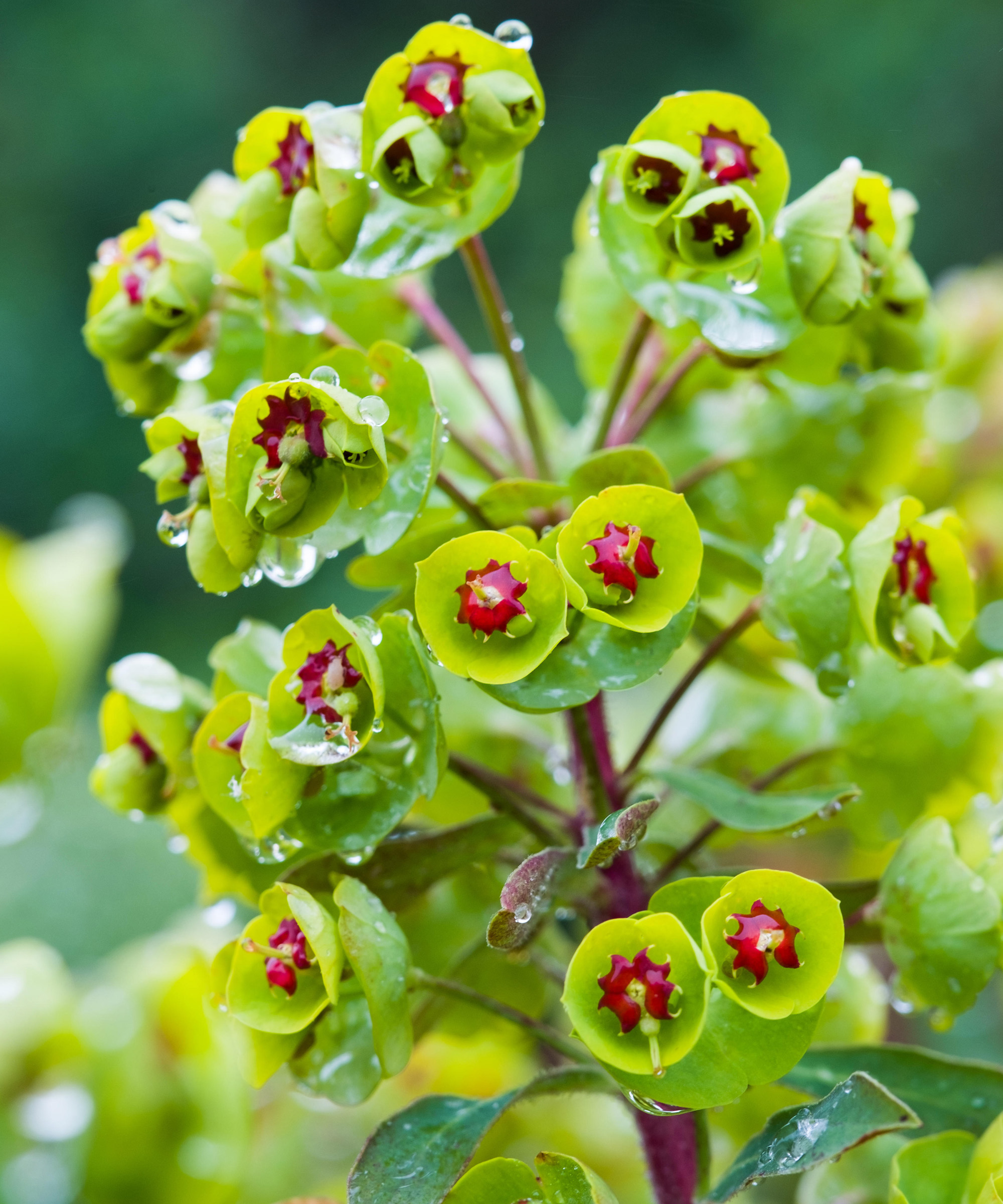
- Hardiness: USDA 6-11
- Height: 24in (60cm)
- Best for: Red contrasts
If you are keen to punctuate your garden with pockets of red flowers or trees with red leaves, these euphorbias will present a fabulous contrast. Euphorbia x martinii are compact shrubs with mounds of evergreen rosettes and red-tinged leaves in spring, followed by heads of lime-green flowers with a dark centre from April to July.
These euphorbias work hard for their spot in your garden and provide a long season of interest. First discovered in southern France, this striking dwarf evergreen is a hybrid between E. amygdaloides and E. characias.
10. Euphorbia sarawschanica
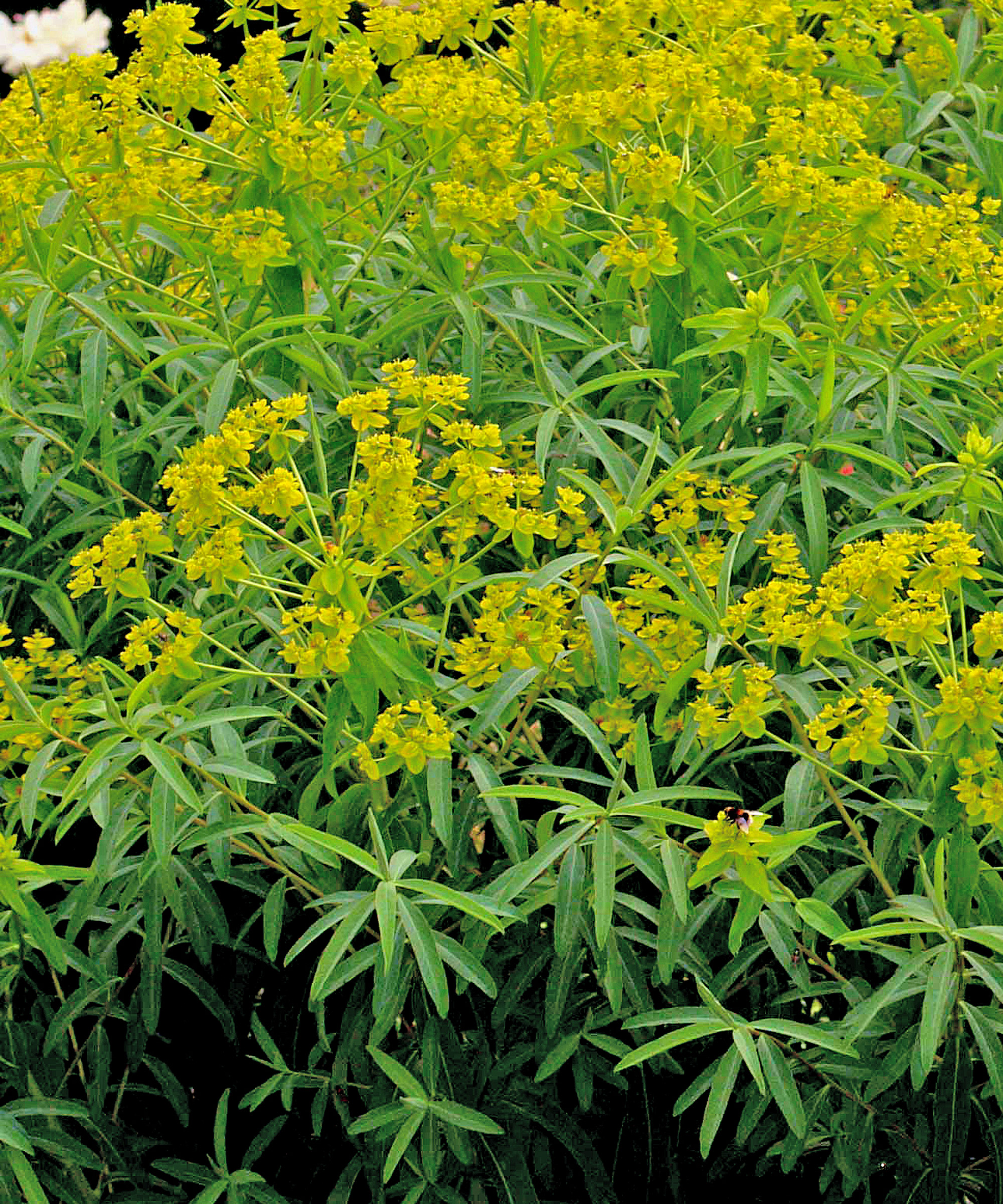
- Hardiness: USDA 4-10
- Height: 47in (120cm)
- Best for: Tall flowers
Admirers of Beth Chatto’s plants and gardens will want to try this next euphorbia. An upright herbaceous perennial, Euphorbia sarawschanica is a new introduction at Beth Chatto. These euphorbias have lovely tall, upright stems, fine sage-green leaves and lime-yellow flowers from June to September.
Team these statuesque euphorbia with similarly sweeping floral planting partners. If you grow echinacea this green gem works wonders. Tall-stemmed types of dahlias also make dramatic companions in late summer borders.
11. Euphorbia palustris AGM
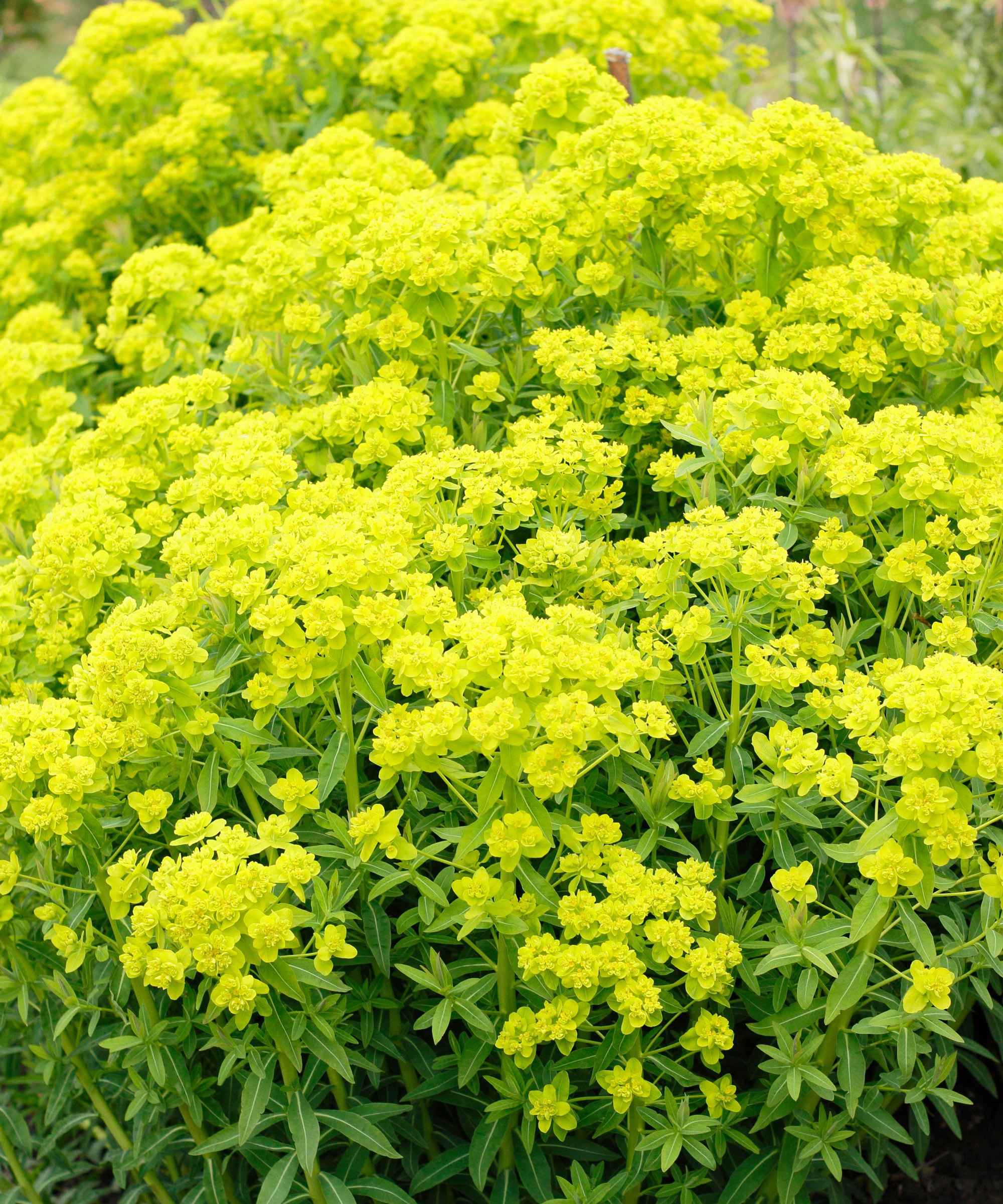
- Hardiness: USDA 5-10
- Height: 35in (90cm)
- Best for: Richer soils
These euphorbias are so luminescent, you’d be forgiven for thinking they glow in the dark! Euphorbia palustris flowers with masses of fresh green flowers from mid to late spring. However, it also keeps the interest going through to autumn with its lively golden-green leaves.
Known as marsh spurge, these euphorbias thrive in richer soils. So if you aren’t sure which soil types you have, it’s worth finding out so you can make the most of this stunning plant. Looks lovely alongside perennials such as Gaura lindheimeri and persicaria.
12. Euphorbia sikkimensis AGM
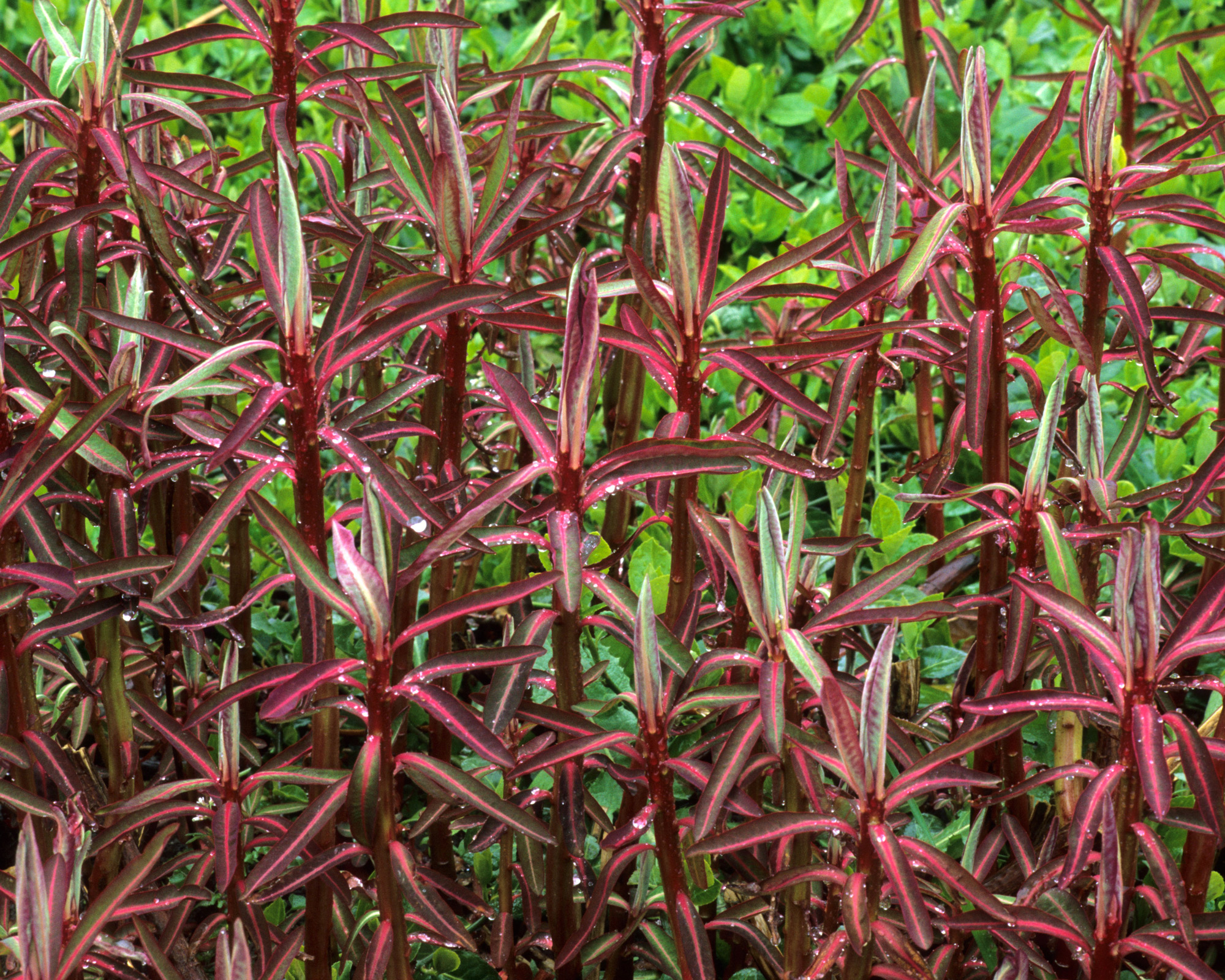
- Hardiness: USDA 6-10
- Height: 40in (1m)
- Best for: Backs of borders
If you’re on a quest for the best foliage plants for your garden, this unique euphorbia gives you a brilliant combination of height and color. Euphorbia sikkimensis is a tall Himalayan species. This clump-forming herbaceous perennial has leaves and stems that emerge pink in late winter, with flowers appearing from July to September.
These types of euphorbia look particularly striking when positioned at the backs of borders. They make a winning spectacle in combination with late flowering perennials such as crocosmias.
13. Euphorbia myrsinites AGM
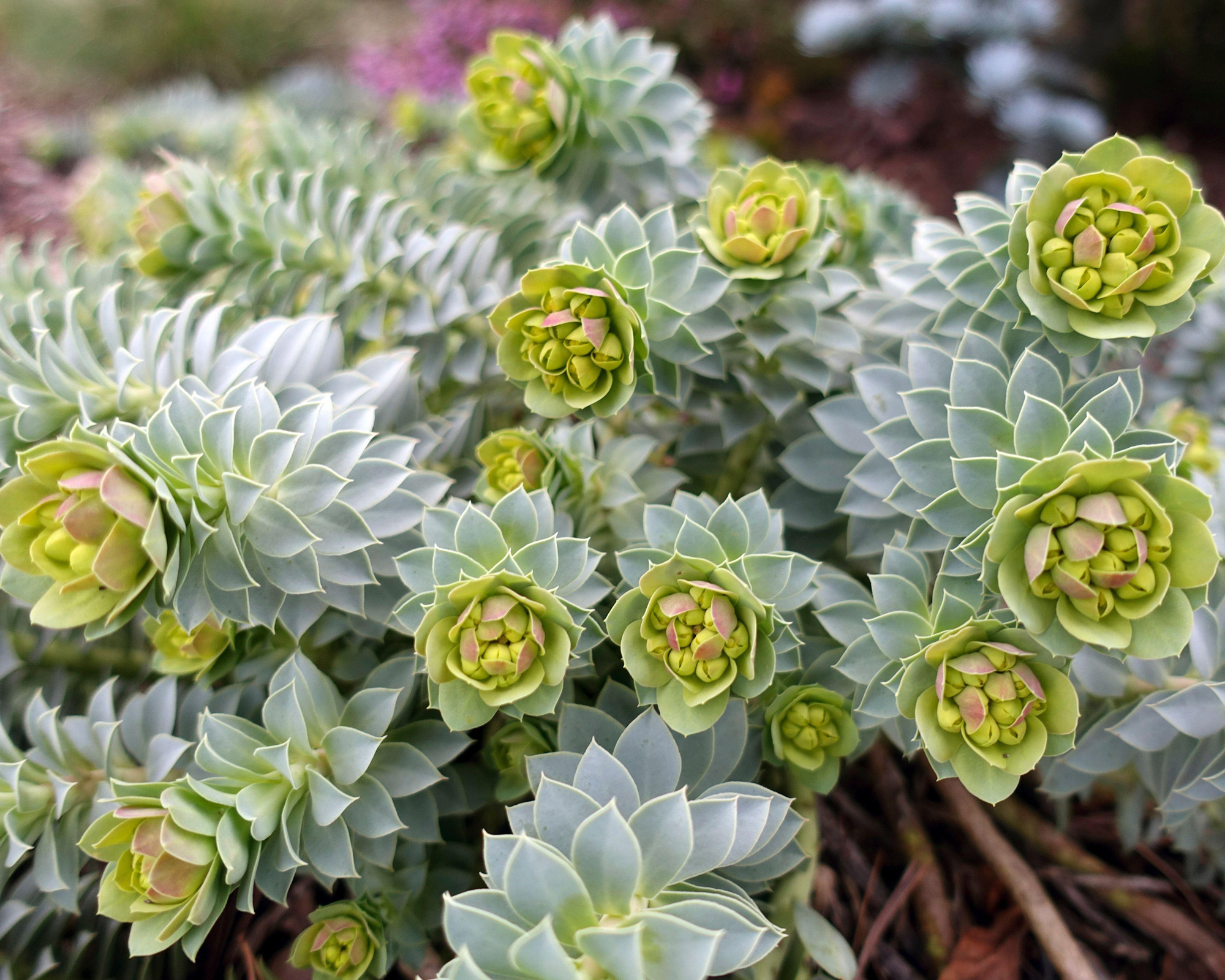
- Hardiness: USDA 5-9
- Height: 12in (30cm)
- Best for: Containers
While many types of euphorbia prefer life in the ground, there are a few that adapt well to spacious container gardening ideas – as long as you pick a good-sized pot! Euphorbia myrsinites is a very low spreading variety that looks great tumbling from containers.
These euphorbias also look brilliant at the front of a border, spilling over the edge onto a path. With flowers from early to mid spring, it adds some cheerful and zingy contrasts to orange or blue types of ornamental grass and works especially well with smaller festuca type grasses.
14. Euphorbia polychroma
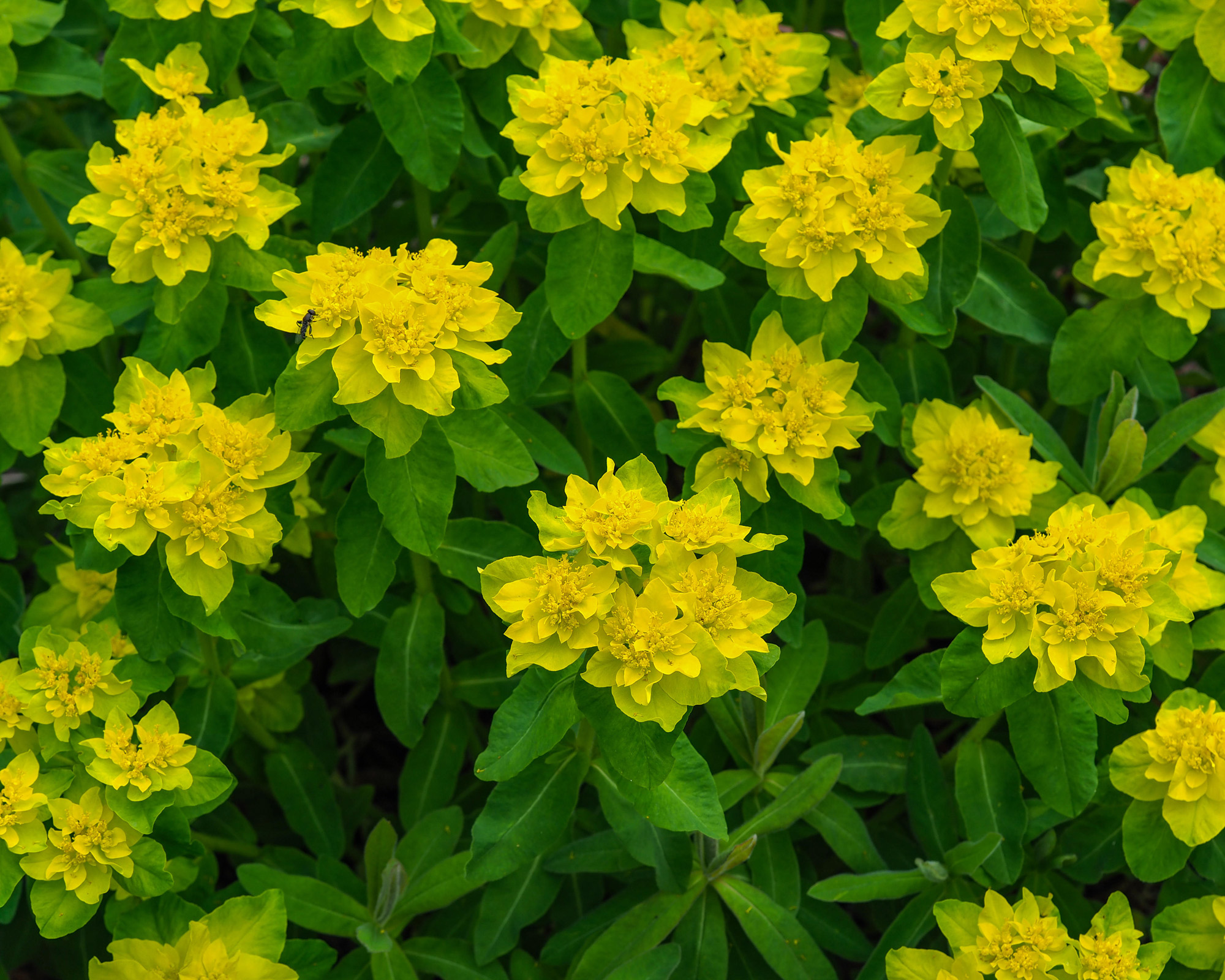
- Hardiness: USDA 4-8
- Height: 12in (30cm)
- Best for: Garden borders
Also known as the cushion spurge, this showy dome-like perennial is one of the more dramatic types of euphorbia. Euphorbia polychroma is certainly one of the best for low maintenance garden borders, spreading in lovely mounds with golden yellow spring blooms.
These euphorbias look especially dazzling when grouped with different types of tulips and other spring-flowering bulbs. The long-lasting flowers of this densely growing euphorbia will smooth the color transition as bulbs fade.
15. Euphorbia cyparissias ‘Fens Ruby’
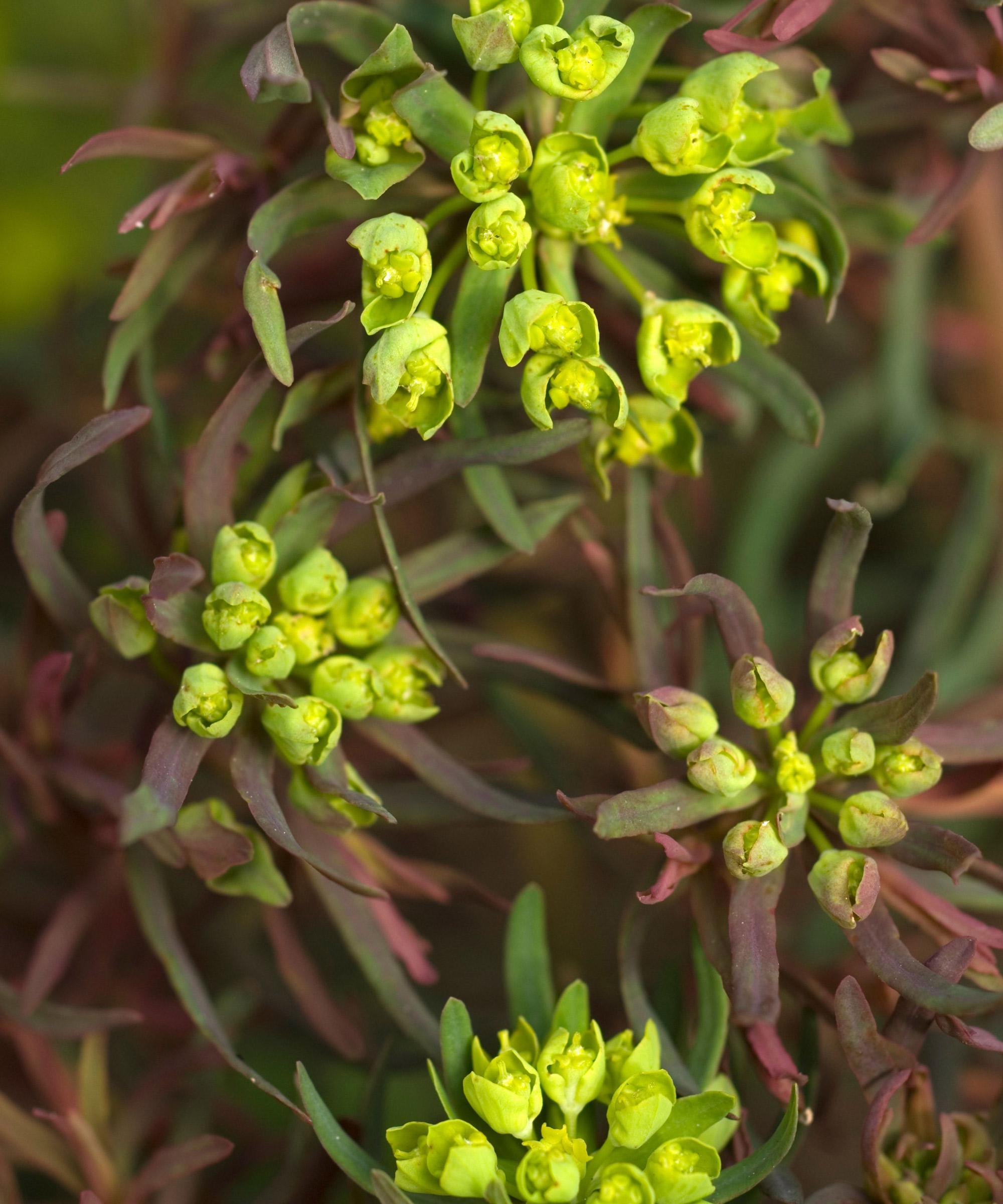
- Hardiness: USDA 4-8
- Height: 16in (40cm)
- Best For: Ground cover
Plants that are fast-spreading, easy-going and low growing quite often make excellent ground cover. If you’re looking for the best ground cover plants, you’ll want to try one of the fastest-spreading types of euphorbia. Euphorbia cyparissias ‘Fens Ruby’ is amongst the most striking.
As well as being a quick-spreader, this euphorbia will tolerate poor soil so it makes good semi-evergreen ground cover in a sunny spot. With its alluring blueish-green foliage and bright spring chartreuse flowers, this plant looks fantastic teamed with geraniums.
16. Euphorbia ‘Blackbird’ (‘Nothowlee’)
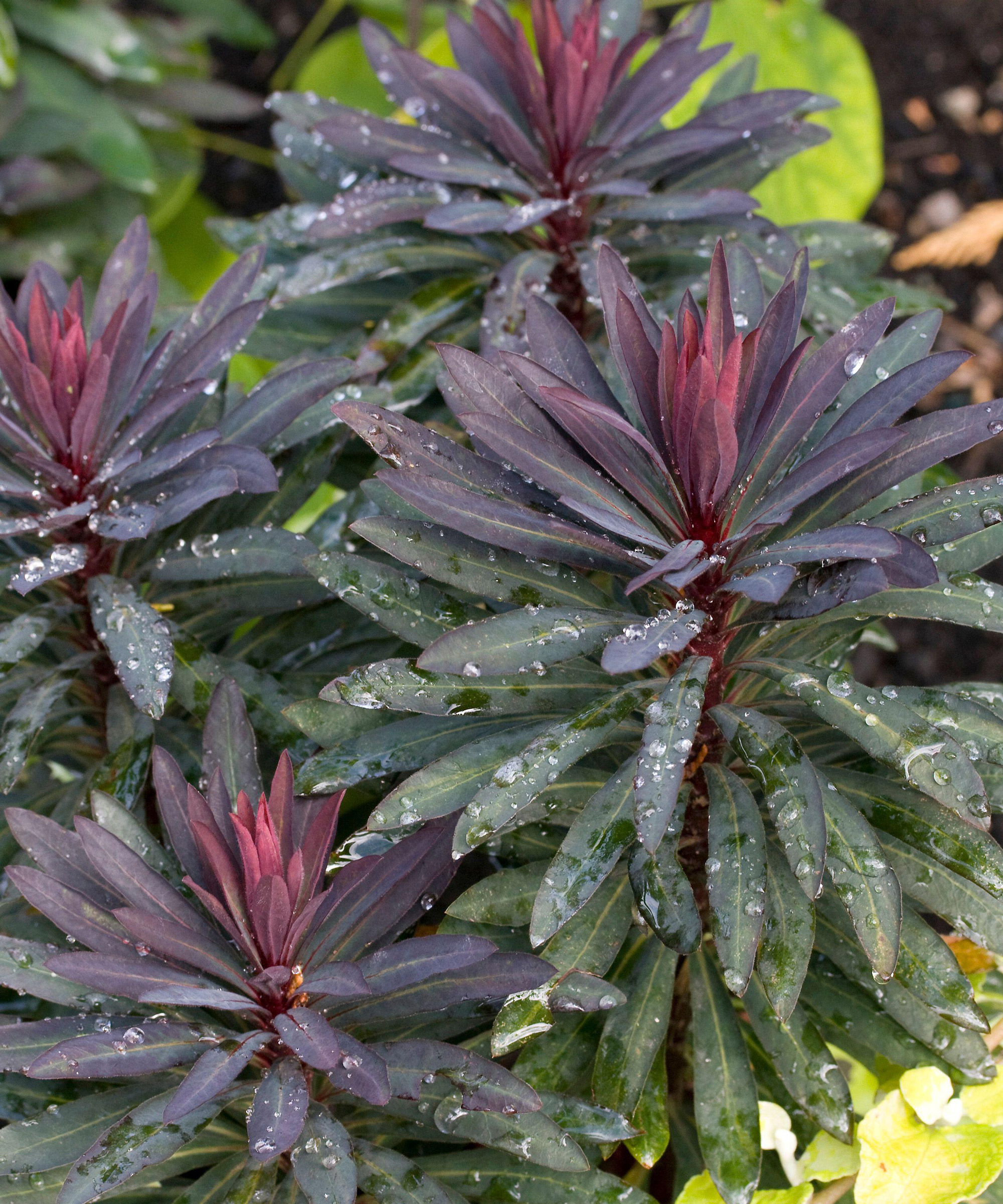
- Hardiness: USDA 6-9
- Height: 18in (45cm)
- Best for: Sunny borders
Many types of euphorbia deliver a startling punch of gold and green that can single-handedly transform a quiet corner of the garden. However, this particular selection is especially effective as part of a broader scheme of yellow flowers and golden plant, as it provides a deep, rich contrast.
Euphorbia ‘Blackbird’ (‘Nothowlee’) with its dark purple foliage, is a great choice for the front of a sunny border or for containers. Combine with golden grasses and flowering spring bulbs. As well as accentuating yellow tones, this plant also works well with silver planting schemes.
Which types of euphorbia spread easily?
Many types of euphorbia are rhizomatous types of plants, and therefore they will spread away from the parent plant. This can be an advantage – for example, in tricky areas or dry shade, E. amygdaloides var. robbiae will work brilliantly as low maintenance ground cover plants and can be left to naturalise.
In smaller gardens, this could be a problem, but you can manage clumps by division every couple of years, replenishing your stock with the younger plants. Some varieties will self-seed, but you can pot up any unwanted seedlings to share with other gardeners. Alternatively, you can cut back the flowers before they set seed.
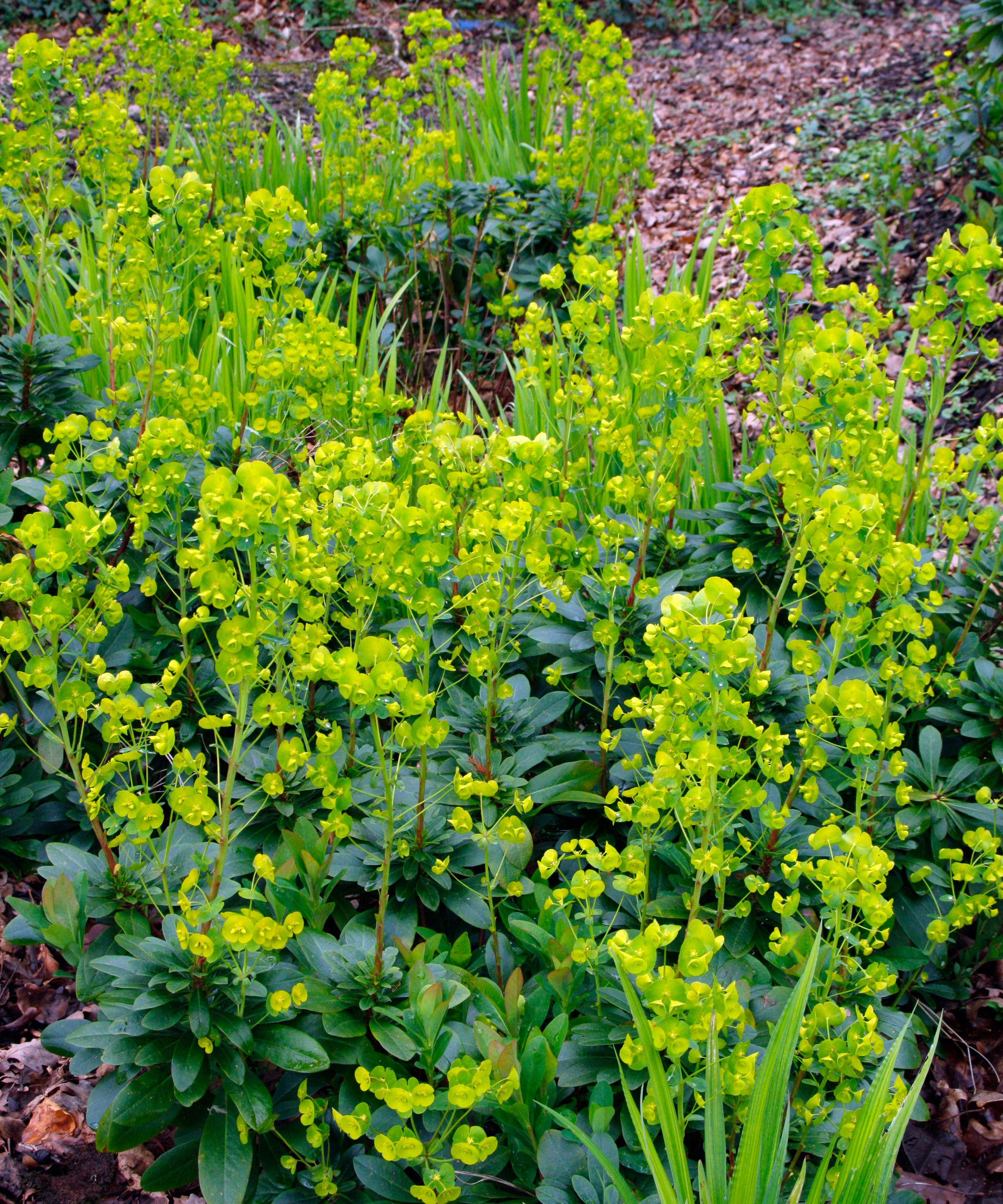
Do all types of euphorbia need deadheading?
You’re probably expecting to spend a bit of time deadheading flowers as your spring and early summer displays transition and fade. Luckily, when it comes to most types of euphorbia, the flowers tend to look good for months after they have peaked. So you don’t need to deadhead, unless you want to prevent them from self-seeding.
By mid-summer, your euphorbias might be looking past their best. So grab your best secateurs and cut flowering stems right back to the base on larger specimens such as E.wulfenii, allowing the foliage to come to the fore. Remember to always wear gloves when cutting euphorbias to protect against the milky sap.

In her years of gardening, Camilla has designed planting schemes for gardens large and small in and around London, written about plants and how to grow them, and worked on BBC gardening TV shows. She's passionate about sharing tips, advice and the joy of plants in this great community of gardeners that we’re all part of, and she now also works as a therapeutic horticulturist, teaching growing for wellbeing and mental health. Her unfulfilled ambition is to crack the ultimate dog-friendly garden - she thinks getting it right depends more on the dog than the plants...
